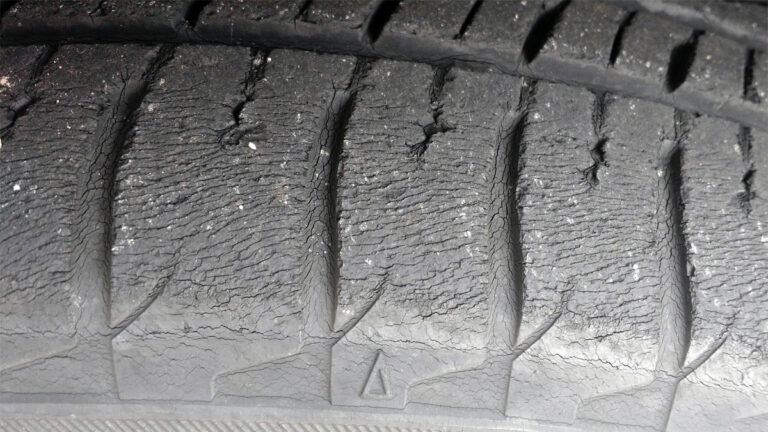How Do Tires Get Dry Rot

Dry rot, also known as sidewall cracking or weather cracking, is a common problem that plagues tires, especially those that sit unused for extended periods. Understanding how dry rot occurs is crucial for prolonging tire life, ensuring safe driving, and avoiding costly replacements. As an experienced DIYer, grasping the underlying mechanisms will empower you to make informed decisions about tire maintenance and storage.
Understanding Tire Composition and Degradation
To understand dry rot, we first need to appreciate the fundamental components of a tire. Tires aren't just solid rubber; they're complex composites designed for specific performance characteristics.
Key Specs and Main Parts
- Tread: The outermost layer providing grip and traction. Made from a robust rubber compound designed to resist abrasion.
- Sidewall: The side of the tire, providing structural integrity and information like tire size, load rating, and speed rating. This is the area most susceptible to dry rot.
- Bead: The reinforced edge of the tire that seals against the wheel rim.
- Carcass: The tire's structural framework, consisting of layers of fabric cords (typically polyester, nylon, or rayon) embedded in rubber. These cords provide strength and shape retention.
- Belt Package: Layers of steel or other materials placed between the carcass and the tread to improve stability and puncture resistance.
- Rubber Compounds: A complex mixture of natural and synthetic rubbers, carbon black, oils, and various chemical additives.
The rubber compounds are where the magic (and the eventual degradation) happens. They're specifically formulated to provide the desired balance of grip, wear resistance, and flexibility. However, these compounds are also susceptible to environmental factors.
The Chemistry Behind Dry Rot
Dry rot isn't literally "rot" like in wood caused by fungi. It's a chemical breakdown of the rubber compounds due to several factors:
- Oxidation: Oxygen in the air reacts with the rubber polymers, causing them to become brittle and lose elasticity. This is accelerated by heat and UV exposure.
- Ozone Degradation: Ozone (O3), a highly reactive form of oxygen, is particularly damaging to rubber. It breaks down the chemical bonds in the polymer chains, leading to surface cracking. Ozone is produced by electrical equipment (motors, welders, etc.) and is more prevalent in urban environments.
- UV Exposure: Ultraviolet (UV) radiation from sunlight accelerates the oxidation process and can directly degrade rubber polymers.
- Evaporation of Oils: Rubber compounds contain oils that keep the rubber pliable. Over time, these oils evaporate, leaving the rubber dry and prone to cracking. This is particularly noticeable in tires that sit unused.
- Flex Cracking: Repeated flexing of the tire can exacerbate existing cracks and lead to further degradation, especially if the rubber is already compromised by oxidation or ozone.
How It Works
The process typically begins with the formation of microscopic cracks on the tire's surface, primarily on the sidewall. These cracks are initially superficial, but over time, they deepen and widen, eventually compromising the tire's structural integrity. The rubber becomes hard and inflexible, losing its ability to properly absorb shocks and maintain grip. Think of it like repeatedly bending a paperclip – eventually, it weakens and breaks.
The rate of dry rot depends on several factors, including:
- Climate: Hot, sunny climates with high ozone levels accelerate dry rot.
- Tire Age: Older tires are more susceptible, as the rubber compounds have had more time to degrade.
- Storage Conditions: Tires stored in direct sunlight or near ozone-generating equipment will degrade faster.
- Tire Composition: Some rubber compounds are more resistant to dry rot than others.
- Use: Infrequent use leads to less flexing, reducing oil distribution within the rubber and accelerating surface drying.
Real-World Use: Troubleshooting and Prevention
Recognizing the signs of dry rot early is key to preventing tire failure.
- Visual Inspection: Regularly inspect your tires for small cracks on the sidewalls. Pay particular attention to tires that are several years old or that have been stored for a long time.
- Feel the Rubber: The sidewall of a tire with dry rot will feel harder and less pliable than a new tire.
- Check the Date Code: The tire's DOT code includes a four-digit number indicating the week and year of manufacture. A tire older than six years, even if it looks good, should be carefully inspected for dry rot.
Preventive measures can significantly extend tire life:
- Proper Storage: Store tires in a cool, dark, and dry place away from direct sunlight and ozone-generating equipment. Consider using tire covers to protect them from UV radiation.
- Tire Rotation: Regularly rotating your tires ensures even wear and distributes the load, potentially delaying the onset of dry rot.
- Tire Conditioners: While controversial, some tire conditioners claim to protect against UV and ozone damage. Be cautious, as some products can actually accelerate degradation. Research carefully before using any tire conditioner.
- Maintain Proper Inflation: Underinflated tires generate more heat, which can accelerate rubber degradation.
Safety Considerations
Driving on tires with significant dry rot is extremely dangerous. The compromised rubber can lead to:
- Blowouts: A sudden and catastrophic tire failure, especially at high speeds.
- Loss of Control: Reduced grip and stability, making it difficult to steer and brake effectively.
- Tire Separation: The tread separating from the carcass.
The sidewall is a critical structural component of the tire, and cracks in this area are a serious warning sign. Do not attempt to repair dry-rotted tires. Replacement is the only safe option.
Conclusion
Understanding the science behind dry rot allows you to proactively manage your tires and ensure your safety on the road. By regularly inspecting your tires, storing them properly, and addressing any signs of dry rot early, you can prolong their life and avoid potentially dangerous situations.
We have a detailed diagram illustrating the tire construction and the process of dry rot. You can download it here.
